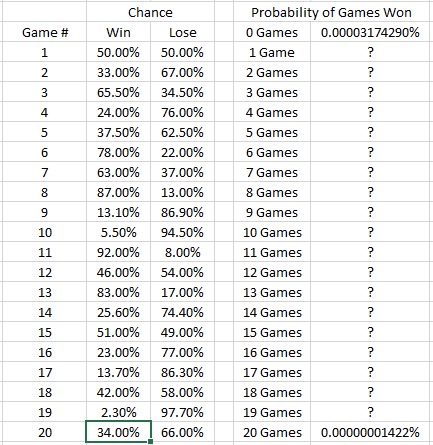Greetings; I spent some time searching but did not seem to find the answer I'm looking for, so hopefully this is not a repeat question. Nevertheless, I feel like this should have a simple answer; I just don't know what it is.
Say I have a finite list of multiple independent events (no real limit on the number of such, but for the example I'll use 20), and each event has a known probability of occurrence. While I don't need the odds of every possible permutation of events, I am interested in calculating the odds for the number of events which occur.
Perhaps a clarifying example: if the each event represents a game played, and each game has a known win probability, what are the odds of winning 0 games, 1 game, 2 games, ... 20 games? Obviously the calculation is easy for 0 or 20 games, but there are too many permutations for a brute force approach to the other 19 possibilities.
Any assistance would be greatly appreciated. Thanks!
Say I have a finite list of multiple independent events (no real limit on the number of such, but for the example I'll use 20), and each event has a known probability of occurrence. While I don't need the odds of every possible permutation of events, I am interested in calculating the odds for the number of events which occur.
Perhaps a clarifying example: if the each event represents a game played, and each game has a known win probability, what are the odds of winning 0 games, 1 game, 2 games, ... 20 games? Obviously the calculation is easy for 0 or 20 games, but there are too many permutations for a brute force approach to the other 19 possibilities.
Any assistance would be greatly appreciated. Thanks!






